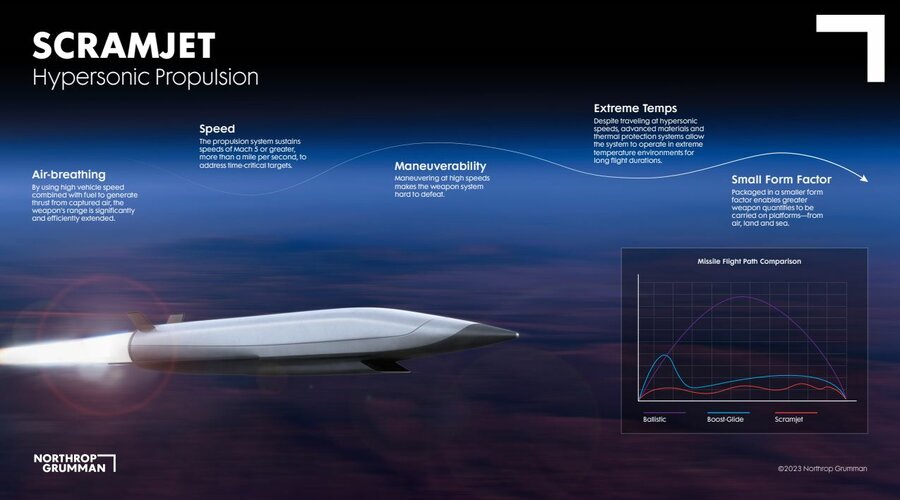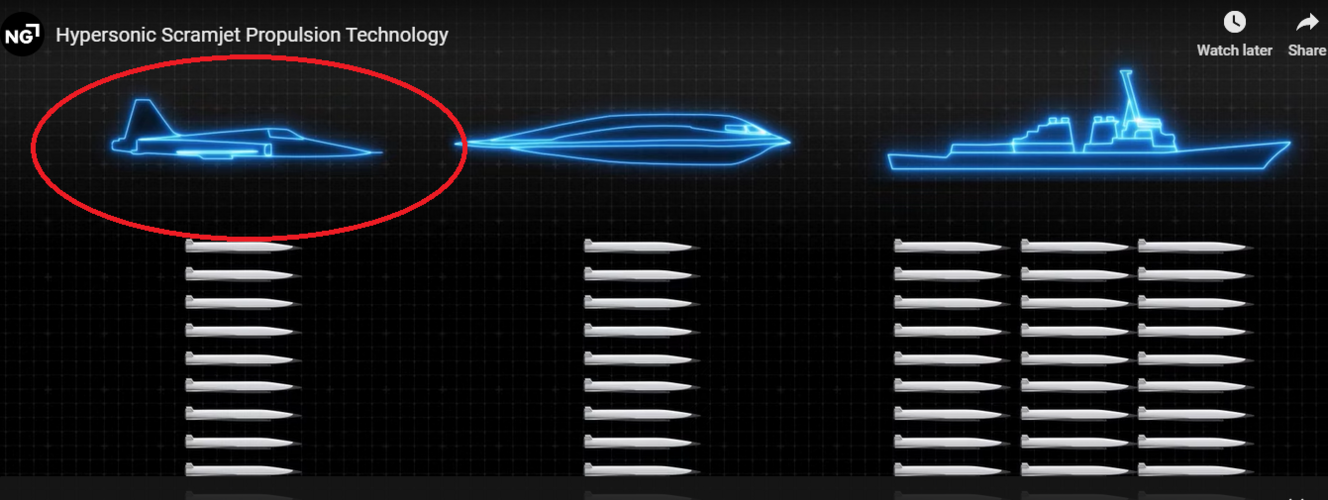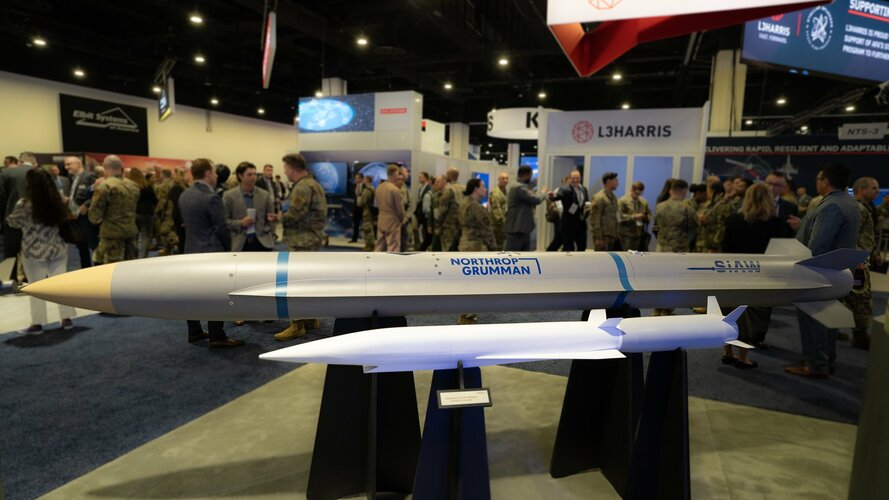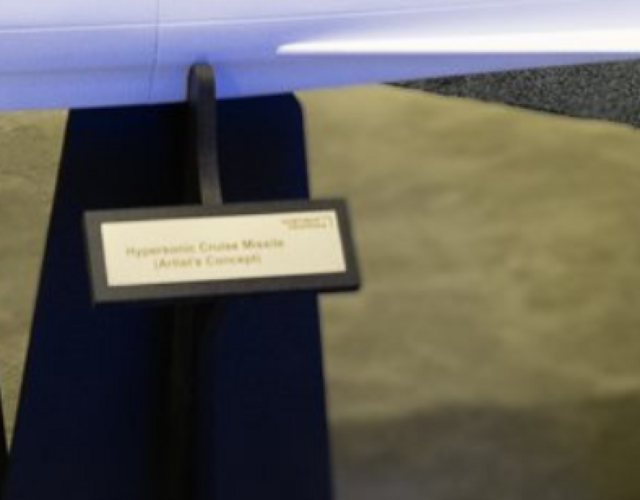You are using an out of date browser. It may not display this or other websites correctly.
You should upgrade or use an alternative browser.
You should upgrade or use an alternative browser.
HAWC (Hypersonic Air-breathing Weapon Concept) and HACM (Hypersonic Attack Cruise Missile)
- Thread starter Forest Green
- Start date
aonestudio
I really should change my personal text
- Joined
- 11 March 2018
- Messages
- 2,546
- Reaction score
- 5,974
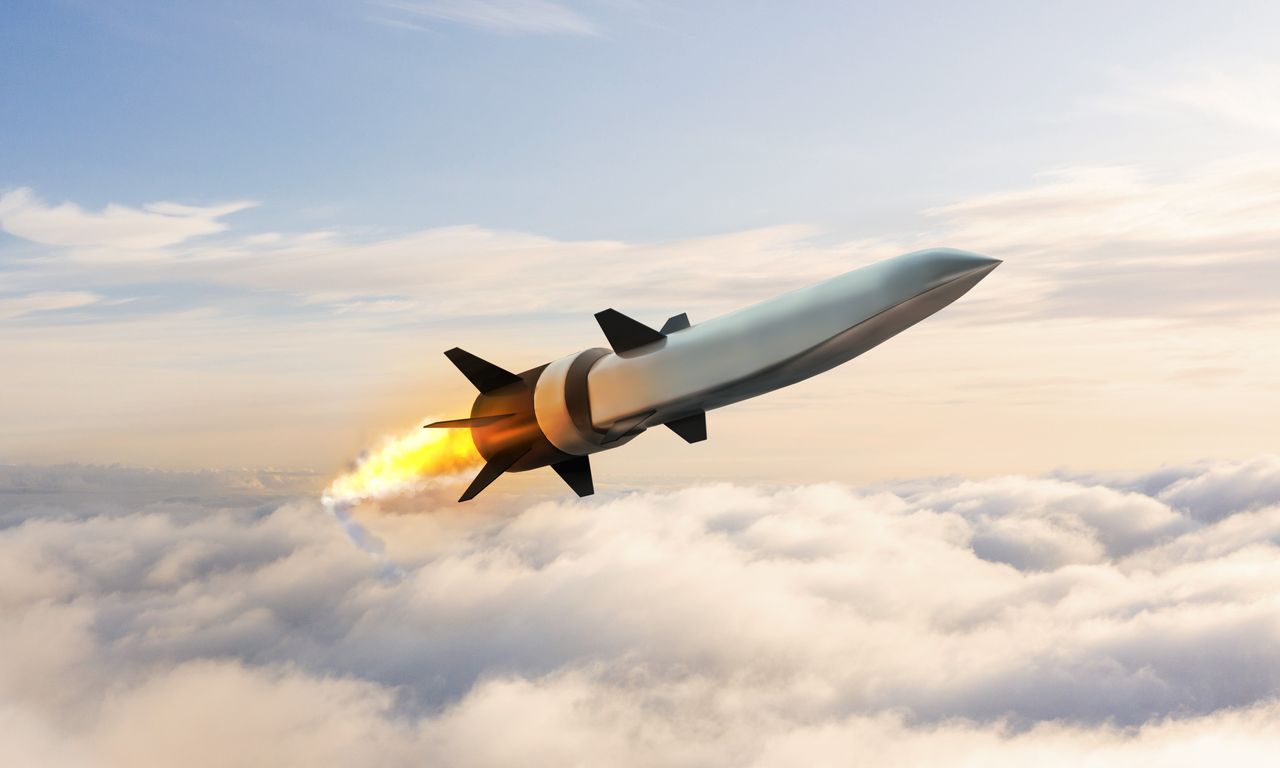
Raytheon Missiles & Defense, Northrop Grumman Complete Second Hypersonic Weapon Flight Test
TUCSON, Ariz. – July 18, 2022 – Raytheon Missiles & Defense, a Raytheon Technologies (NYSE: RTX) business, in partnership with Northrop Grumman (NYSE: NOC), successfully completed its second flight test of the scramjet-powered Hypersonic Air-breathing...
TUCSON, Ariz. – July 18, 2022 – Raytheon Missiles & Defense, a Raytheon Technologies (NYSE: RTX) business, in partnership with Northrop Grumman (NYSE: NOC), successfully completed its second flight test of the scramjet-powered Hypersonic Air-breathing Weapon Concept, or HAWC, for the Defense Advanced Research Projects Agency and the U.S. Air Force.
This flight test applied the data and lessons learned from the first flight to mature the operationally relevant weapon concept design. The test met all primary and secondary objectives, including demonstrating tactical range capabilities.
“The test demonstrated how we’ve rapidly matured affordable scramjet technology, which is the basis for air-breathing weapons,” said Colin Whelan, president of Advanced Technology for Raytheon Missiles & Defense. “Our second HAWC flight test success is an important milestone for our nation as we advance hypersonic systems.”
During the flight test, after releasing HAWC from an aircraft and accelerating to hypersonic speeds using the scramjet engine, the vehicle flew a trajectory that engineers designed to intentionally stress the weapon concept to explore its limits and further validate digital performance models. These models, grounded in real-world flight data, are being used to accurately predict and increase performance as the system matures.
“The second flight test is a big step toward scramjet technology being mission ready,” said Dan Olson, vice president and general manager, weapon Systems, Northrop Grumman. “Nearly twenty years of scramjet propulsion research and development have come to fruition to significantly advance our nation’s weapon capabilities.”
aonestudio
I really should change my personal text
- Joined
- 11 March 2018
- Messages
- 2,546
- Reaction score
- 5,974
Two-for-two: Hypersonic missile passes second consecutive test
Successful tests confirm industry team's digital design and model accuracy
August 16, 2022
A hypersonic cruise missile co-developed by Raytheon Technologies has passed its second flight test in a row – an important milestone in the U.S. Department of Defense’s plan to field weapons that travel faster than five times the speed of sound.
The test, conducted in July 2022, featured a Hypersonic Air-breathing Weapon Concept, with minor improvements informed by its earlier successful test in September 2021. Its performance in the most recent test – it dropped from an aircraft and accelerated beyond Mach 5 – met the predictions of the company’s data models.
"Advancing our nation's hypersonic capabilities is a critical national imperative, and this was an important step forward," said Wes Kremer, president of Raytheon Missiles & Defense, a Raytheon Technologies business. "Having back-to-back successful flight tests gives us even greater confidence in the technical maturity of our HAWC operational prototype."
aonestudio
I really should change my personal text
- Joined
- 11 March 2018
- Messages
- 2,546
- Reaction score
- 5,974
Final Flight of HAWC Program Screams Through the Sky
1/30/2023
The joint DARPA and U.S. Air Force Hypersonic Airbreathing Weapon Concept (HAWC) completed yet another successful flight test. The Lockheed Martin version of the missile, with its Aerojet Rocketdyne scramjet, capped a program that accomplished all of its initial objectives. It was the final flight test for HAWC, which is providing critical data to inform Air Force Research Laboratory (AFRL) hypersonic technology maturation efforts.
“This month’s flight added an exclamation point to the most successful hypersonic airbreathing flight test program in US history,” said Walter Price, an Air Force deputy for the HAWC program. “The things we’ve learned from HAWC will certainly enhance future U.S. Air Force capabilities.”
The Lockheed Martin missile again flew at speeds greater than Mach 5, higher than 60,000 feet, and farther than 300 nautical miles. This latest flight demonstrated improved capabilities and performance. The nation’s hypersonic portfolio now has two feasible hypersonic airbreathing missile designs (Lockheed Martin and Raytheon) to improve and mature in the future.
“The HAWC program created a generation of new hypersonic engineers and scientists,” said Andrew “Tippy” Knoedler, the HAWC program manager. “HAWC also brought a wealth of data and progress to the airbreathing hypersonic community. The industry teams attacked the challenge of scramjet-powered vehicles in earnest, and we had the grit and luck to make it work.”
Even though the HAWC program has executed the final phase of the program, there is still data to analyze and more opportunities to mature the technology. DARPA plans to continue that maturation in the More Opportunities with HAWC (MOHAWC) program by building and flying more vehicles that build upon HAWC’s advances. Those missiles will expand the operating envelope of the scramjet and provide technology on-ramps for future programs of record.
“We had our share of difficulties,” said Knoedler. “Through a pandemic, a strained supply chain, and atmospheric rivers, our industry partners forged ahead, mitigating the risks where they could and accepting others. They delivered on their promises, proving the feasibility of the concept.”
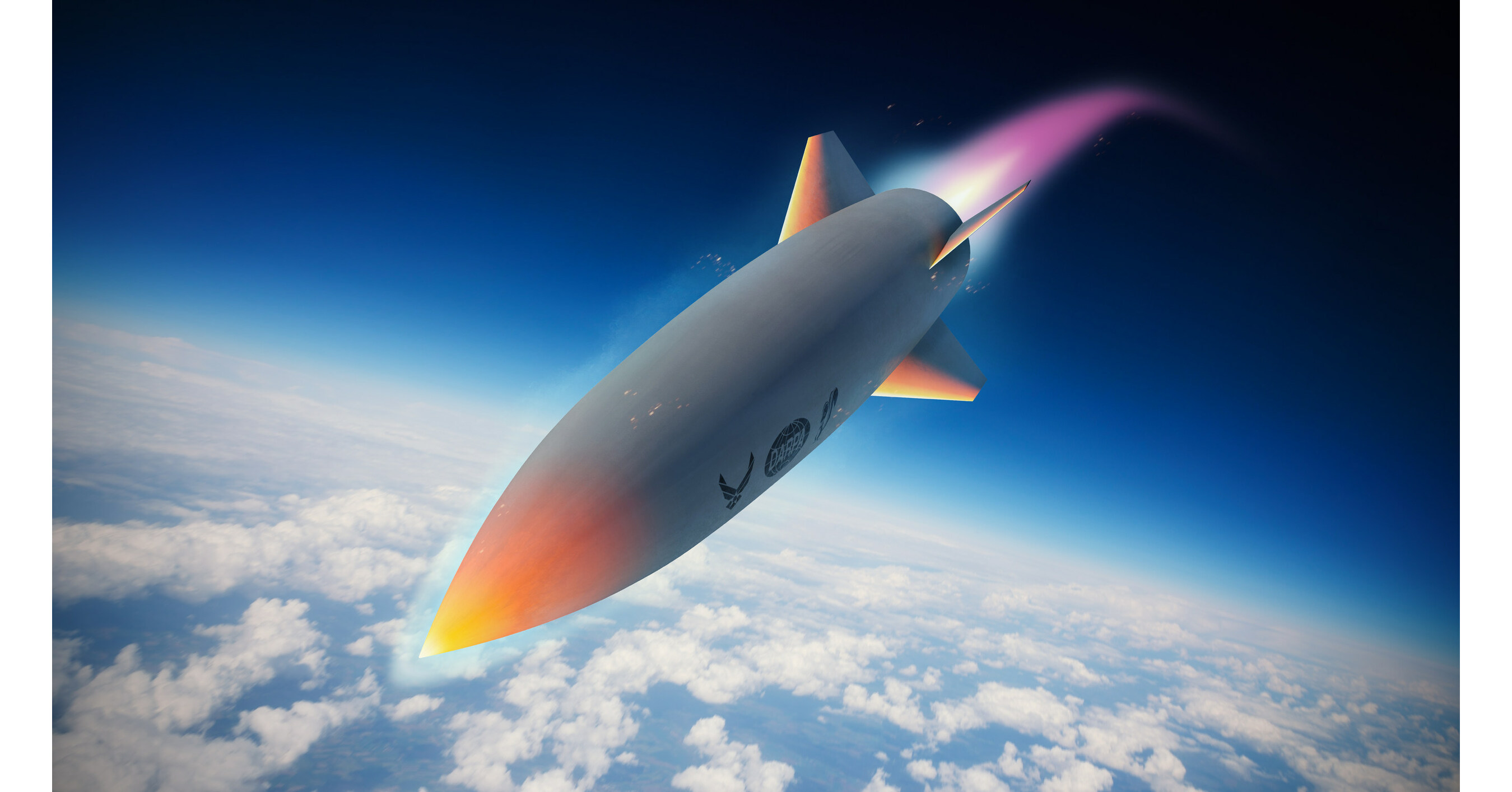
DARPA, AFRL, Lockheed Martin and Aerojet Rocketdyne Team's Second Hypersonic Air-breathing Weapon Concept Launched from B-52 Accomplishes All Test Objectives
DARPA's Latest HAWC Flight Test Demonstrates Mature, Affordable Hypersonic Systems Design and Manufacturing Techniques PALMDALE, Calif., Jan. 30, 2023 /PRNewswire/ -- The Defense Advanced Research...
aonestudio
I really should change my personal text
- Joined
- 11 March 2018
- Messages
- 2,546
- Reaction score
- 5,974
Interesting that the missile isn’t depicted with a booster…I’ve been hoping for some kind of render of the entire HAWC stack. It also is pictured as having a very different length to width ratio than the X-51 cruiser, though probably not worth reading too much into a marketing video.
Even the quantity make no sense haha
Forest Green
ACCESS: Above Top Secret
- Joined
- 11 June 2019
- Messages
- 5,133
- Reaction score
- 6,787
Yes, it would appear the humble F-5 can carry as many as a B-2 and a third as many as a guided missile destroyer.Even the quantity make no sense haha
donnage99
ACCESS: Top Secret
- Joined
- 16 June 2008
- Messages
- 1,216
- Reaction score
- 409
Y'all playing checkers while northrop playing chess.
That's how many missiles it would take when all ignite would propell an f-5 or b-2 or ddg-51 to mach 5 speed.
At mach 5 even a single sailor with an M4 rifle standing on deck would become an anti armor bunker busting killing machine.
That's how many missiles it would take when all ignite would propell an f-5 or b-2 or ddg-51 to mach 5 speed.
At mach 5 even a single sailor with an M4 rifle standing on deck would become an anti armor bunker busting killing machine.
- Joined
- 21 April 2009
- Messages
- 13,175
- Reaction score
- 6,072
Aerojet Rocketdyne's Advanced Scramjet Engine Powers Hypersonic Vehicle Flight in Partnership with DARPA, AFRL, Lockheed Martin | Aerojet Rocketdyne
HUNTSVILLE, Ala., Feb. 22, 2023 – In partnership with the Defense Advanced Research Projects Agency (DARPA), Air Force Research Laboratory (AFRL) and Lockheed Martin team, an advanced Aerojet Rocketdyne scramjet engine powered the recent flight (announced Jan. 30) of the Hypersonic Air-breathing...
aonestudio
I really should change my personal text
- Joined
- 11 March 2018
- Messages
- 2,546
- Reaction score
- 5,974
Forest Green
ACCESS: Above Top Secret
- Joined
- 11 June 2019
- Messages
- 5,133
- Reaction score
- 6,787
Is this the MOHAWC program or something new?
FighterJock
ACCESS: Top Secret
- Joined
- 29 October 2007
- Messages
- 4,230
- Reaction score
- 3,423
I wouldn't like to say Josh_TN, on the other hand I want it to be something new.
- Joined
- 16 April 2008
- Messages
- 8,403
- Reaction score
- 10,374
Is this the MOHAWC program or something new?
It is MOHAWC.
Aerojet Rocketdyne doing the engine, correct?
NG makes the scramjet. I'd assume Orbital would make the solid rocket booster since they were bought out but that's a guess.
- Joined
- 1 April 2006
- Messages
- 10,731
- Reaction score
- 6,774
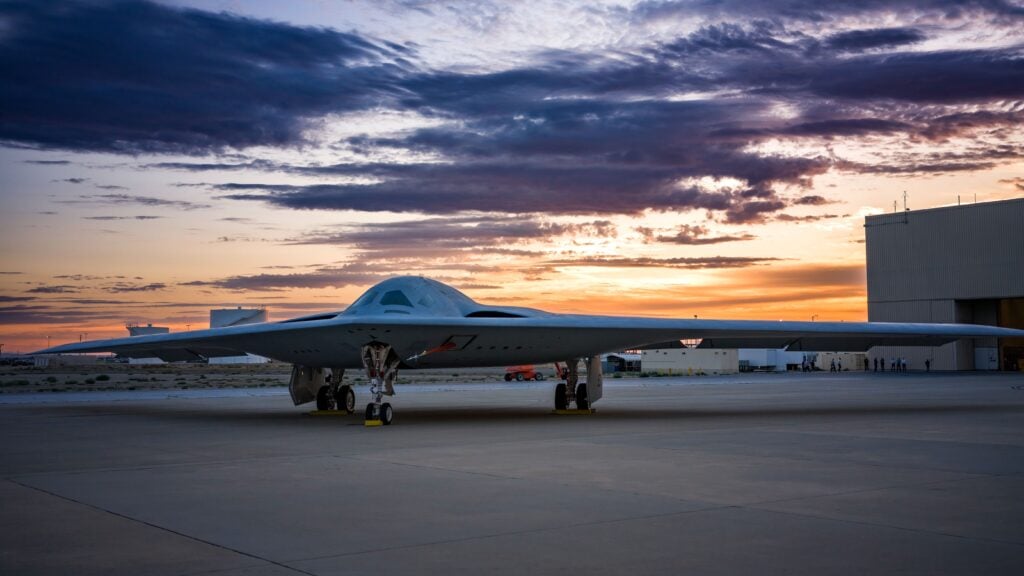
The top news from AFA 2023 day 3 [VIDEO] - Breaking Defense
Breaking Defense’s Aaron Mehta and Michael Marrow discuss the top news from the last day of the Air and Space Forces Association’s annual conference.
Attachments

The top news from AFA 2023 day 3 [VIDEO] - Breaking Defense
Breaking Defense’s Aaron Mehta and Michael Marrow discuss the top news from the last day of the Air and Space Forces Association’s annual conference.breakingdefense.com
Is there any indication as to whether the model in the foreground is to scale? I assume that AGM-88G/SiAW is full sized.
Forest Green
ACCESS: Above Top Secret
- Joined
- 11 June 2019
- Messages
- 5,133
- Reaction score
- 6,787
SiAW and HACM?
The top news from AFA 2023 day 3 [VIDEO] - Breaking Defense
Breaking Defense’s Aaron Mehta and Michael Marrow discuss the top news from the last day of the Air and Space Forces Association’s annual conference.breakingdefense.com
Forest Green
ACCESS: Above Top Secret
- Joined
- 11 June 2019
- Messages
- 5,133
- Reaction score
- 6,787
- Joined
- 16 April 2008
- Messages
- 8,403
- Reaction score
- 10,374
I would say no, because that would make it shorter than a sidewinder. Probably more related to exhibition space.
On zoom:
View attachment 707789
I was just going to mention that. It seems to say "artists concept" so there's no guarantee it even resembles the actual missile, much less that it is to scale.
Forest Green
ACCESS: Above Top Secret
- Joined
- 11 June 2019
- Messages
- 5,133
- Reaction score
- 6,787
Forest Green
ACCESS: Above Top Secret
- Joined
- 11 June 2019
- Messages
- 5,133
- Reaction score
- 6,787
Wow...flight testing scheduled within a year.
The fact that there is already a blk2 is intriguing. Perhaps like PrSM, the initial version is INS/GPS guidance only with room for a terminal seeker as a follow on? This also the first I've heard of F-18 integration. Presumably this is for the RAAF? IIRC the F-18 wing stations have a lower capacity than the F-15's (3500? 4000? compared to 5000) so that tells us a little more about the maximum weight the weapon could be. I'm personally guess 3000-3500 lbs.
The fact that there is already a blk2 is intriguing. Perhaps like PrSM, the initial version is INS/GPS guidance only with room for a terminal seeker as a follow on? This also the first I've heard of F-18 integration. Presumably this is for the RAAF? IIRC the F-18 wing stations have a lower capacity than the F-15's (3500? 4000? compared to 5000) so that tells us a little more about the maximum weight the weapon could be. I'm personally guess 3000-3500 lbs.
Forest Green
ACCESS: Above Top Secret
- Joined
- 11 June 2019
- Messages
- 5,133
- Reaction score
- 6,787
Isn't HACM supposed to have a range of 1,000km though? It's looking a little light for that right now. Centreline pylon maybe?Wow...flight testing scheduled within a year.
The fact that there is already a blk2 is intriguing. Perhaps like PrSM, the initial version is INS/GPS guidance only with room for a terminal seeker as a follow on? This also the first I've heard of F-18 integration. Presumably this is for the RAAF? IIRC the F-18 wing stations have a lower capacity than the F-15's (3500? 4000? compared to 5000) so that tells us a little more about the maximum weight the weapon could be. I'm personally guess 3000-3500 lbs.
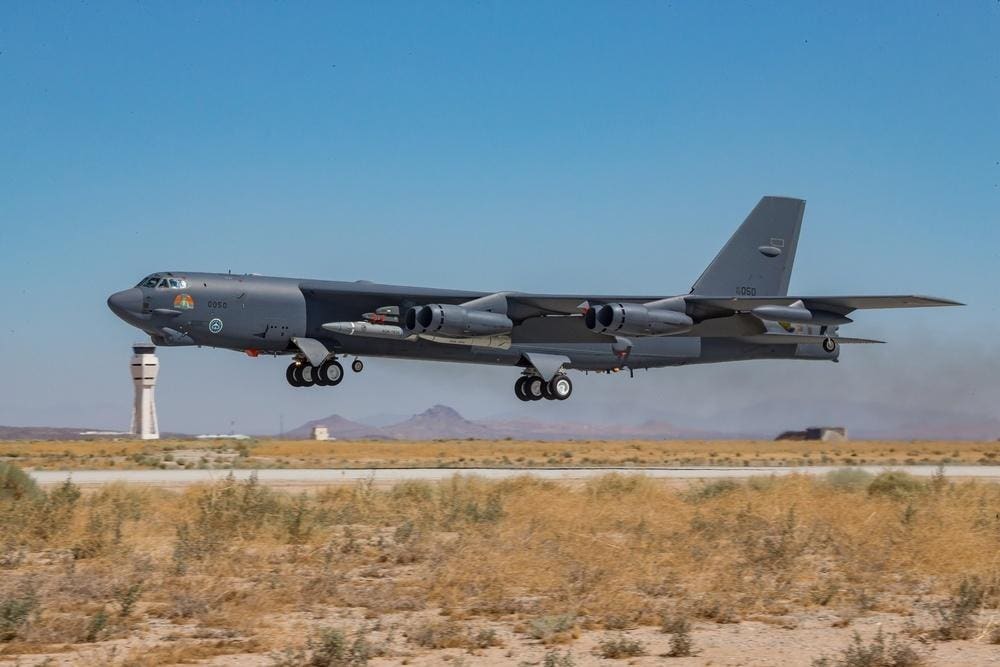
Is DoD’s Approach To Buying Hypersonic Weapons Too Expensive?
A former Lockheed Martin Skunk Works executive says the Pentagon’s desire for long-range hypersonic missiles simply costs too much.
 www.forbes.com
www.forbes.com
For each of these missiles DoD is seeking a 1,000 nautical mile standoff range.
Isn't HACM supposed to have a range of 1,000km though? It's looking a little light for that right now. Centreline pylon maybe?

Is DoD’s Approach To Buying Hypersonic Weapons Too Expensive?
A former Lockheed Martin Skunk Works executive says the Pentagon’s desire for long-range hypersonic missiles simply costs too much.www.forbes.com
Not sure I buy that line. I think the was true of the ARRW but not necessarily HACM. The HAWC demonstrators were said to have reached 300 miles (or maybe nm, I forgot). I think this more realistic for HACMs range. A thousand miles would make for a missile so heavy that I do not think tactical aircraft could carry it, because not only does the size of the cruiser increase, but the booster needed to get it up to speed starts to multiply as well. X-51 got >200nm out of 270 lbs of fuel. HAWC probably used a much more efficient engine, or at least a much lighter one that allowed for more fuel. But then you have to add in volume and weight for warhead. Several hundred miles is probably achievable for tactical fighter launch weights (if we are talking F-18, I think 4000lbs is the limit but I could not find a source). I would guess a 1000 mile stack would be prohibitively large and require a strategic bomber for deployment.
Forest Green
ACCESS: Above Top Secret
- Joined
- 11 June 2019
- Messages
- 5,133
- Reaction score
- 6,787
Is HCSW still on the go? One article mentioned that it weighs 12,000lbs, is it an air-launched LRHW or something?Not sure I buy that line. I think the was true of the ARRW but not necessarily HACM. The HAWC demonstrators were said to have reached 300 miles (or maybe nm, I forgot). I think this more realistic for HACMs range. A thousand miles would make for a missile so heavy that I do not think tactical aircraft could carry it, because not only does the size of the cruiser increase, but the booster needed to get it up to speed starts to multiply as well. X-51 got >200nm out of 270 lbs of fuel. HAWC probably used a much more efficient engine, or at least a much lighter one that allowed for more fuel. But then you have to add in volume and weight for warhead. Several hundred miles is probably achievable for tactical fighter launch weights (if we are talking F-18, I think 4000lbs is the limit but I could not find a source). I would guess a 1000 mile stack would be prohibitively large and require a strategic bomber for deployment.
Is HCSW still on the go? One article mentioned that it weighs 12,000lbs, is it an air-launched LRHW or something?
It was canned a couple years ago after its design review as a cost cutting measure as being too redundant with ARRW. I do not think we learned much about it but I believe it did use the same LRHW glide body and as such I suspect it was an air launched version of the same without the first stage, but that is just a personal guess. It apparently could only be carried two at a time by a B-52 which was seen as a major limitation, but it was a lower risk program than ARRW because it used more off the shelf tech. It would suffer all of the same cost penalties of ARRW while being carried in fewer number; I am confident it is forever off the table.
Found this randomly while I was looking for the pylon ratings for F-18s; thought it useful in the context of HAWC to have some details about X-51 in one slide:
In case it gets pulled down -
Stack: 3942 lb (stack gross weight captive carry)
fuel: 265 lb (JP-7)
Cruiser launch weight: 1507 lb
Cruiser operating weight: 1225 (?)
Booster: 2207 lb
Flow through interstage: 160 lb
301" stack length, 168" cruiser length, 23" max body width
In case it gets pulled down -
Stack: 3942 lb (stack gross weight captive carry)
fuel: 265 lb (JP-7)
Cruiser launch weight: 1507 lb
Cruiser operating weight: 1225 (?)
Booster: 2207 lb
Flow through interstage: 160 lb
301" stack length, 168" cruiser length, 23" max body width
There's almost no dimensional data available on the HCSW. If we assume a launch weight of 12,000 lbs., a properly configured B-52H might be able to carry four, since it was designed to carry four Skybolts @ 11,000 lbs. each. Agree with Josh that it would have been procured in small numbers and a loadout of two would have been more likely.It was canned a couple years ago after its design review as a cost cutting measure as being too redundant with ARRW. I do not think we learned much about it but I believe it did use the same LRHW glide body and as such I suspect it was an air launched version of the same without the first stage, but that is just a personal guess. It apparently could only be carried two at a time by a B-52 which was seen as a major limitation, but it was a lower risk program than ARRW because it used more off the shelf tech. It would suffer all of the same cost penalties of ARRW while being carried in fewer number; I am confident it is forever off the table.
Tangentially, a couple of years ago the Air Force issued an RFP for a B-52 pylon with 20,000 lb. capacity. That would cover the spectrum of two HSCWs, four AGM-183s, or (maybe) four AGM-181s per side. And, yes, also a bunch of JSSAMs or LRASMs.
Tangentially, a couple of years ago the Air Force issued an RFP for a B-52 pylon with 20,000 lb. capacity. That would cover the spectrum of two HSCWs, four AGM-183s, or (maybe) four AGM-181s per side. And, yes, also a bunch of JSSAMs or LRASMs.
Isn’t AGM-181 more of a 3000 lb store? And would use the nuclear pylon currently in use for AGM-86? Also there was a recent RFI for piping that pylon with MIL-1760 so it could carry heavy conventional stores, implied to be future hypersonic cruise missiles.
Sure -- I was speaking of the B-52H's potential carrying capacity. Not sure of the launch weight of the AGM-181 but I agree, it would seem logical to re-use the AGM-86 pylon if that's possible.Isn’t AGM-181 more of a 3000 lb store? And would use the nuclear pylon currently in use for AGM-86? Also there was a recent RFI for piping that pylon with MIL-1760 so it could carry heavy conventional stores, implied to be future hypersonic cruise missiles.
Similar threads
-
-
-
"Why and Whither Hypersonics Research in the US Air Force"
- Started by robunos
- Replies: 5
-
-
Lockheed Martin AGM-183 Air-Launched Rapid Response Weapon (ARRW)
- Started by Moose
- Replies: 652

